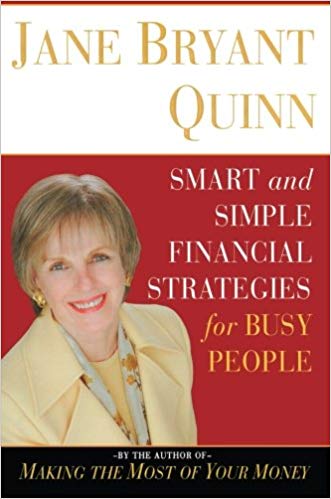
Review of Smart and Simple Financial Strategies for Busy People by Jane Bryant Quinn
I just finished reading Jane Bryant Quinn’s new book, Smart and Simple Financial Strategies for Busy People. I’ve had it for a few weeks but the holidays stole my reading time. Now that you’ve read my excuse, let’s get to the review.
Quinn (stepmom to former MTV veejay, Martha Quinn) follows the title’s premise throughout the entire book, focusing on making personal finance understandable and simple. Even a novice like myself — I will forever be a novice as there is always so much more to learn — found clarity in issues that have been foggy. The eight sections of the book are designed for the path that most of us will take in matters of personal finance, from beginning to analyze expenses and saving, through eliminating debt, buying a house, paying for college, and smarter investing.
Quinn stresses the importance of starting early, taking advantage of compounding, sticking with low-cost index funds which beat managed funds over time, diversifying, and keeping your hands off except for the occasional rebalancing.
There are very few “anecdotes” in this book, which to me is a positive choice. Many books, even Lee Eisenberg’s The Number, rely on an interruption of the information to tell a story exemplifying a single point. Smart and Simple puts the information out there effectively without the need for personal stories, imagined or actual, to flesh out the text.
The person who would most benefit from this book is the individual who is beginning an interest in personal finance. Those who are more experienced will likely already understand many of the concepts Quinn takes care to explain. However, there is something for everyone. I found the section on buying a house very informative; the chapter outlined many of the confusing details about important mortgage aspects, such as alternative mortgage types and points, with which I’ve had no experience. Other chapters answered my questions and challenged my conceptions of 529 plans and municipal bonds.
The author often mentions her favorite websites and books relating to the particular topic at hand. Here’s one instance as she wraps up the chapter on buying a house. She steers away from talking about purchasing a house as an investment until the end:
Real estate can be profitable as long as you understand that it’s a business, not a hobby or get-rich-quick game. Before even starting, bone up on the principles. My favorite guides are… by John Reed, available only through his website at Johntreed.com. Reed also has a terrific Web page called Real Estate Guru Ratings… If you’re interested in investing, this will steer you to good guys and away from the many charlatans in the game.
I’ll use the section on insurance as a guide when it becomes a necessary purchase for me and my family.
In the interest of Keeping It Simple, Quinn left some holes. Although I don’t consider myself a numbers person, I wanted more than just the few calculation tables included. For example, rather than presenting charts to describe the benefits of low-cost idnex funds over higher-cost, the author points to an online calculator. I’d rather turn to an appendix where I can look at numbers and see the differences clearly calculated.
Smart and Simple Financial Strategies for Busy People by Jane Bryant Quinn is a great book for the twenty-something (or older) who is discovering that sensible personal finance is an important responsibility. (While a teenager could benefit from much of the information included, there are other books that are better for the young beginner.) Quinn’s practical approach to keeping finance simple makes the book perfect for forming a solid basis and growing from that initial point, while reminding the reader “all that really matters is getting more out of life.”
There doesn’t seem to be an “official website” for this book or for the author, Jane Bryant Quinn. However, you can purchase the book from Amazon.com or listen to an audio introduction by Quinn, courtesy of Newsweek.


Article comments
Jane Bryant Quinn’s new book is brilliant. It peels away the fluff and lays out a clear path to getting and staying ahead financially. I like the way you point out the strengths of various chapters. Thank you.
Mary Ann
Just reviewed the book on:
Money And Investing
Flexo: Thanks for mentioning my post. We have differing opinions on the book but our backgrounds are much different as well. Blog on!
No problem, thc.
I added a link to an audio introduction voiced by Quinn. Her voice is not as I had imaged, although I’m not quite sure what I did imagine.
Me too. I’m posting on it tomorrow.
Yes, I did. It was a comfortable read and I’d recommend the book to others, especially if they fall into the target audience mentioned above.
So, did you like it?